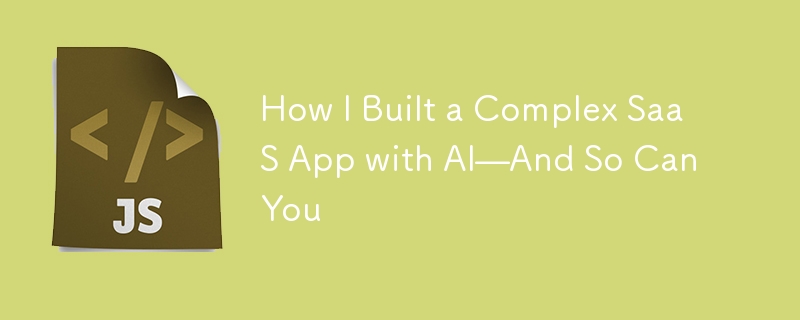Home >Web Front-end >JS Tutorial >How I Built a Complex SaaS App with AI—And So Can You
How I Built a Complex SaaS App with AI—And So Can You
- WBOYWBOYWBOYWBOYWBOYWBOYWBOYWBOYWBOYWBOYWBOYWBOYWBOriginal
- 2024-08-24 11:01:32529browse

I've been a developer for a few years now but its not until AI came out that I was able to start building apps. My first language to learn was visual basic. I never got the hang of it, nothing about it was basic. Next was C++, still nothing was adding up, even with the two plus signs. To my defense, I didn't own a computer when learning it and it was taught on a whiteboard.
The Discovery
I've been using LLMs for a quite a while, at least since the first GPT4 version came out. I had just finished learning blockchain development with Solidity and had gotten a job at a software agency. And that's when GPT4 was released. At first I was just asking general questions. Then I started using it to code by testing with some Solidity code.
It did quite well and that's when my spark for using AI to code lit up. At the time I was working in a software agency and we got a client that wanted a script that automatically bought NFTs from a Solana marketplace below a certain price. I did the whole project with GPT4.
The App Idea
When Claude, was released, I was skeptical and decided to hold off for a bit, as I played with the free models.
Eventually, I got the hang of it and decided to subscribe. After a while, Claude Opus was my favorite model, using it for personal coding projects and general research. Soon after, Claude 3.5 Sonnet was announced.
Building
Around this time, I came up with an idea for a vscode extension that can expand AIs capabilities by bringing it to the IDE and give it write and read access, therefore giving the AI real-time context.
I decided to start building with Claude 3.5 Sonnet. Right of the bat, we got off to a good start and I had a few things working. However, minutes later, something broke in the code and I went in circles for about an hour with Sonnet, trying to fix it. I got frustrated and switched back to the model I was familiar with, Opus.
However, right of the bat I was fixing error after error. But I kept on as I was still used to Opus and reluctant to switch. But after fiddling with Opus for about 2 days, I realized I had gotten nowhere near as far as I had with Sonnet. So I went back to Sonnet, fetched the last version of code that was working and began afresh from there.
It was at this point that things started falling into place. Within a week I had code that I could at least run and test. The more I understood how to prompt, the faster I was able to work with it.
Challenges
However, it wasn't all smooth sailing. There are several instances, but the most significant was at one point, since I was also using it for research and architectural decisions, it suggested a wrong approach that was not possible with my setup. Given that I wasn't aware of this, I implemented it and on testing it didn't work.
On consulting the errors with Sonnet, it still couldn't understand why the module wasn't working. So I did more consulting for the implementation with chatGPT. It also suggested the same approach (that didn't work) but gave me a second option. I took the second one, gave it to Claude, and Voila! the train was moving again.
The Result
All in all it, it took around 2 months to come up with a viable application. I ended up with more than 10 modules, which I find suitable for scalability and debugging.
Based on my experience, I've realized the quality of AI has reached a level where you can implement and iterate on ideas with amazing speed.
The current limitation with coding with AI, is you're limited to back and forth copying and pasting. Which works, but sometimes, when there's an error, there could be a gap in the context since the AI might not know how your current project is setup in the IDE and the error isn't communicating that.
Since both the AI and you are not aware, you both end up in circles. That's what I'm solving with codingAGI, bring AI to the IDE and have it set up the environment, write the code, run it and receive immediate context in the form of a success message or an error, which it can then debug.
Conclusion
AI is not going to replace developers. You still need to prompt it and guide it to achieve the result you want. Which means knowing software design principles and patterns. The difference will be speed. AI developers will ideate faster, code faster and ship faster.
Check out CodingAGI and start shipping!
The above is the detailed content of How I Built a Complex SaaS App with AI—And So Can You. For more information, please follow other related articles on the PHP Chinese website!
Related articles
See more- An in-depth analysis of the Bootstrap list group component
- Detailed explanation of JavaScript function currying
- Complete example of JS password generation and strength detection (with demo source code download)
- Angularjs integrates WeChat UI (weui)
- How to quickly switch between Traditional Chinese and Simplified Chinese with JavaScript and the trick for websites to support switching between Simplified and Traditional Chinese_javascript skills

